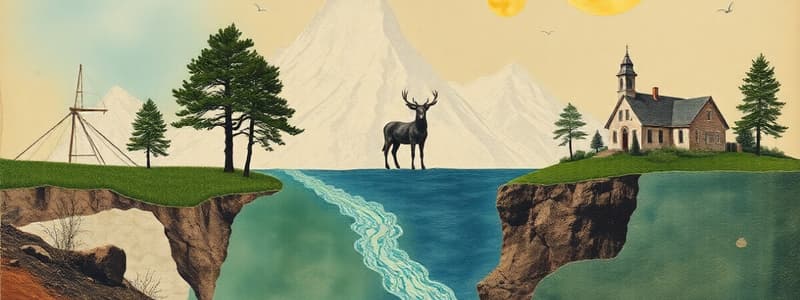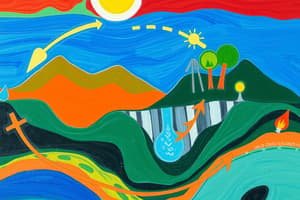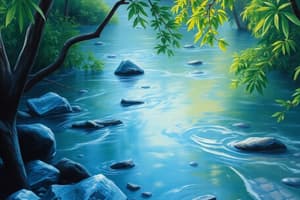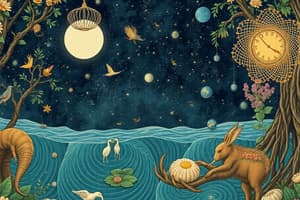Podcast
Questions and Answers
Which process moves carbon from the lithosphere into the atmosphere?
Which process moves carbon from the lithosphere into the atmosphere?
- Volcanism (correct)
- Deforestation
- Condensation
- Transpiration
Transpiration moves water from the atmosphere into the biosphere.
Transpiration moves water from the atmosphere into the biosphere.
False (B)
What is the term for the problem caused by fertilizers entering the hydrosphere?
What is the term for the problem caused by fertilizers entering the hydrosphere?
eutrophication
Bacteria in root nodules move nitrogen from the ______ into the biosphere.
Bacteria in root nodules move nitrogen from the ______ into the biosphere.
Match the process to the correct cycle:
Match the process to the correct cycle:
Which process releases nitrogen as nitrites and nitrates into the lithosphere?
Which process releases nitrogen as nitrites and nitrates into the lithosphere?
Deforestation causes carbon to move from the atmosphere to the biosphere.
Deforestation causes carbon to move from the atmosphere to the biosphere.
How does bacteria contribute to the carbon cycle?
How does bacteria contribute to the carbon cycle?
Lightning moves nitrogen from the atmosphere into the ______ as nitrites and nitrates.
Lightning moves nitrogen from the atmosphere into the ______ as nitrites and nitrates.
Which of the following processes moves water from the biosphere to the atmosphere?
Which of the following processes moves water from the biosphere to the atmosphere?
What process involves the release of water from plant leaves?
What process involves the release of water from plant leaves?
Energy is created and destroyed in ecosystems.
Energy is created and destroyed in ecosystems.
How often is every particle in the human body replaced?
How often is every particle in the human body replaced?
Water vapor condenses to form __________.
Water vapor condenses to form __________.
Match the following water cycle processes with their descriptions:
Match the following water cycle processes with their descriptions:
Which of the following is NOT a part of the water cycle?
Which of the following is NOT a part of the water cycle?
Matter in ecosystems is used up and cannot be replaced.
Matter in ecosystems is used up and cannot be replaced.
What is the primary source of water that enters lakes, oceans, and soil?
What is the primary source of water that enters lakes, oceans, and soil?
Ecosystems require continuous renewal to maintain a __________.
Ecosystems require continuous renewal to maintain a __________.
What is the process called when water turns from liquid to gas?
What is the process called when water turns from liquid to gas?
Which of the following are part of the water cycle?
Which of the following are part of the water cycle?
The majority of Earth's carbon is actively cycled through living organisms.
The majority of Earth's carbon is actively cycled through living organisms.
What are two examples of fossil fuels?
What are two examples of fossil fuels?
The burning of fossil fuels releases ______ into the atmosphere.
The burning of fossil fuels releases ______ into the atmosphere.
Match the following carbon deposits with their descriptions:
Match the following carbon deposits with their descriptions:
Deforestation has a positive impact on the carbon cycle by increasing the amount of carbon stored in trees.
Deforestation has a positive impact on the carbon cycle by increasing the amount of carbon stored in trees.
Which of the following is NOT a way humans impact the carbon cycle?
Which of the following is NOT a way humans impact the carbon cycle?
What is the primary source of nitrogen for living organisms?
What is the primary source of nitrogen for living organisms?
______ convert atmospheric nitrogen into a usable form for plants.
______ convert atmospheric nitrogen into a usable form for plants.
Which of the following is NOT a consequence of excess nitrogen in the environment?
Which of the following is NOT a consequence of excess nitrogen in the environment?
Flashcards
Water Cycle
Water Cycle
The continuous movement of water on, above, and below the surface of the Earth.
Evaporation
Evaporation
The process where liquid water changes into water vapor, rising into the atmosphere.
Condensation
Condensation
The process where water vapor in the air cools and condenses into tiny water droplets, forming clouds.
Precipitation
Precipitation
Signup and view all the flashcards
Groundwater
Groundwater
Signup and view all the flashcards
Transpiration
Transpiration
Signup and view all the flashcards
Cycling of Matter
Cycling of Matter
Signup and view all the flashcards
Energy Flow
Energy Flow
Signup and view all the flashcards
Ecosystem Renewal
Ecosystem Renewal
Signup and view all the flashcards
Origin of Resources
Origin of Resources
Signup and view all the flashcards
What is the water cycle?
What is the water cycle?
Signup and view all the flashcards
What is evaporation?
What is evaporation?
Signup and view all the flashcards
What is condensation?
What is condensation?
Signup and view all the flashcards
What is precipitation?
What is precipitation?
Signup and view all the flashcards
What is surface runoff?
What is surface runoff?
Signup and view all the flashcards
What is groundwater?
What is groundwater?
Signup and view all the flashcards
What is the carbon cycle?
What is the carbon cycle?
Signup and view all the flashcards
What is photosynthesis?
What is photosynthesis?
Signup and view all the flashcards
What is cellular respiration?
What is cellular respiration?
Signup and view all the flashcards
What is nitrogen fixation?
What is nitrogen fixation?
Signup and view all the flashcards
Volcanic Carbon Release
Volcanic Carbon Release
Signup and view all the flashcards
Condensation in the Water Cycle
Condensation in the Water Cycle
Signup and view all the flashcards
Fertilizer and Eutrophication
Fertilizer and Eutrophication
Signup and view all the flashcards
Deforestation and Carbon Release
Deforestation and Carbon Release
Signup and view all the flashcards
Lightning's Role in Nitrogen Cycle
Lightning's Role in Nitrogen Cycle
Signup and view all the flashcards
Transpiration in the Water Cycle
Transpiration in the Water Cycle
Signup and view all the flashcards
Bacteria's Role in Cycles
Bacteria's Role in Cycles
Signup and view all the flashcards
Reforestation and Carbon Sequestration
Reforestation and Carbon Sequestration
Signup and view all the flashcards
Nitrogen Fixation by Legumes
Nitrogen Fixation by Legumes
Signup and view all the flashcards
Activities to Review and Practice
Activities to Review and Practice
Signup and view all the flashcards
Study Notes
Cycling of Matter in Ecosystems
- Ecosystems continually renew and maintain a balanced environment
- All water and nutrients come from particles already present in the environment
- Matter (anything with mass and volume) is reused and transformed repeatedly
- Energy flows through ecosystems as organisms consume each other
- Energy is not created or destroyed, only transformed
- The human body constantly replaces its particles, with an estimated replacement of every particle at least once every seven years
- The cycling of matter and energy are essential for the functioning of ecosystems
The Water Cycle
- The water cycle is the movement of water in its liquid, solid, or gaseous forms around the Earth
- Liquid water evaporates to become water vapor
- Water vapor condenses to form ice crystals or water droplets
- Droplets collect in clouds and fall to Earth as rain, hail, or snow
- Water then enters lakes, oceans, soil, or groundwater, and the cycle repeats
- Plants release water into the atmosphere through transpiration
The Carbon Cycle
- Carbon is present in both biotic and abiotic components of ecosystems
- Carbon (in the form of carbon dioxide and sugars) is cycled during photosynthesis and cellular respiration
- During the carbon cycle, carbon moves between biotic and abiotic parts of ecosystems
- Most Earth's carbon is not cycled, but is stored in various deposits such as coal, limestone, ocean sediments, shells, oil and natural gas (methane or CH4)
- These components form when decomposed organisms are compressed over millions of years
The Nitrogen Cycle
- Most nitrogen exists in the atmosphere
- Nitrogen-fixing bacteria and lightning convert atmospheric nitrogen into usable forms for living things
- Humans add nitrogen to the soil as fertilizer
- Nitrogen is a crucial nutrient for soil and is absorbed by producers, then passed through the food chain to consumers.
- Nitrogen is vital for creating DNA and proteins in living organisms
Human Activities and Ecosystem Cycles
- Auto emissions from burning fossil fuels release carbon dioxide and carbon monoxide into the atmosphere
- Deforestation releases carbon stored in trees when they are burnt or decompose
- Fertilizers introduce nitrogen to the hydrosphere, leading to eutrophication
- Volcanic activity moves carbon from the lithosphere to the atmosphere
- Reforestation moves carbon from the atmosphere into the biosphere
- Lightning moves nitrogen from the atmosphere to the lithosphere, ultimately into the biosphere
Other Important Concepts
- Lithosphere: The solid outer part of the Earth.
- Atmosphere: The gaseous layer surrounding the Earth.
- Biosphere: The zone where life exists on Earth.
- Hydrosphere: The liquid water part of Earth.
Studying That Suits You
Use AI to generate personalized quizzes and flashcards to suit your learning preferences.
Related Documents
Description
Test your knowledge on the cycling of matter within ecosystems and the water cycle. This quiz covers key concepts about how matter and energy flow through ecosystems, as well as the movement of water on Earth. Challenge yourself on these essential environmental topics!




